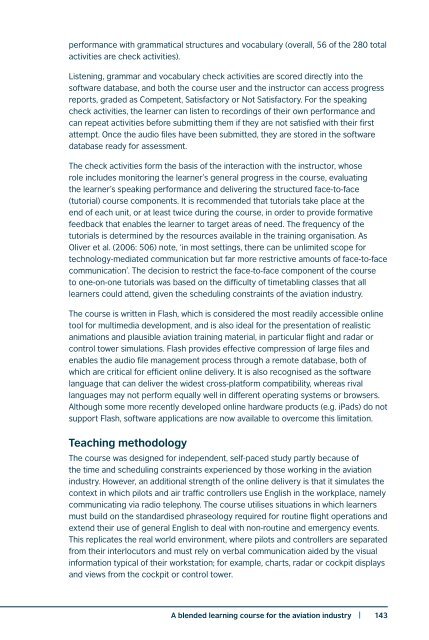Blended Learning in English Language Teaching: Course Design and Implementation
Blended Learning in English Language Teaching: Course Design and Implementation
Blended Learning in English Language Teaching: Course Design and Implementation
Create successful ePaper yourself
Turn your PDF publications into a flip-book with our unique Google optimized e-Paper software.
performance with grammatical structures <strong>and</strong> vocabulary (overall, 56 of the 280 total<br />
activities are check activities).<br />
Listen<strong>in</strong>g, grammar <strong>and</strong> vocabulary check activities are scored directly <strong>in</strong>to the<br />
software database, <strong>and</strong> both the course user <strong>and</strong> the <strong>in</strong>structor can access progress<br />
reports, graded as Competent, Satisfactory or Not Satisfactory. For the speak<strong>in</strong>g<br />
check activities, the learner can listen to record<strong>in</strong>gs of their own performance <strong>and</strong><br />
can repeat activities before submitt<strong>in</strong>g them if they are not satisfied with their first<br />
attempt. Once the audio files have been submitted, they are stored <strong>in</strong> the software<br />
database ready for assessment.<br />
The check activities form the basis of the <strong>in</strong>teraction with the <strong>in</strong>structor, whose<br />
role <strong>in</strong>cludes monitor<strong>in</strong>g the learner’s general progress <strong>in</strong> the course, evaluat<strong>in</strong>g<br />
the learner’s speak<strong>in</strong>g performance <strong>and</strong> deliver<strong>in</strong>g the structured face-to-face<br />
(tutorial) course components. It is recommended that tutorials take place at the<br />
end of each unit, or at least twice dur<strong>in</strong>g the course, <strong>in</strong> order to provide formative<br />
feedback that enables the learner to target areas of need. The frequency of the<br />
tutorials is determ<strong>in</strong>ed by the resources available <strong>in</strong> the tra<strong>in</strong><strong>in</strong>g organisation. As<br />
Oliver et al. (2006: 506) note, ‘<strong>in</strong> most sett<strong>in</strong>gs, there can be unlimited scope for<br />
technology-mediated communication but far more restrictive amounts of face-to-face<br />
communication’. The decision to restrict the face-to-face component of the course<br />
to one-on-one tutorials was based on the difficulty of timetabl<strong>in</strong>g classes that all<br />
learners could attend, given the schedul<strong>in</strong>g constra<strong>in</strong>ts of the aviation <strong>in</strong>dustry.<br />
The course is written <strong>in</strong> Flash, which is considered the most readily accessible onl<strong>in</strong>e<br />
tool for multimedia development, <strong>and</strong> is also ideal for the presentation of realistic<br />
animations <strong>and</strong> plausible aviation tra<strong>in</strong><strong>in</strong>g material, <strong>in</strong> particular flight <strong>and</strong> radar or<br />
control tower simulations. Flash provides effective compression of large files <strong>and</strong><br />
enables the audio file management process through a remote database, both of<br />
which are critical for efficient onl<strong>in</strong>e delivery. It is also recognised as the software<br />
language that can deliver the widest cross-platform compatibility, whereas rival<br />
languages may not perform equally well <strong>in</strong> different operat<strong>in</strong>g systems or browsers.<br />
Although some more recently developed onl<strong>in</strong>e hardware products (e.g. iPads) do not<br />
support Flash, software applications are now available to overcome this limitation.<br />
Teach<strong>in</strong>g methodology<br />
The course was designed for <strong>in</strong>dependent, self-paced study partly because of<br />
the time <strong>and</strong> schedul<strong>in</strong>g constra<strong>in</strong>ts experienced by those work<strong>in</strong>g <strong>in</strong> the aviation<br />
<strong>in</strong>dustry. However, an additional strength of the onl<strong>in</strong>e delivery is that it simulates the<br />
context <strong>in</strong> which pilots <strong>and</strong> air traffic controllers use <strong>English</strong> <strong>in</strong> the workplace, namely<br />
communicat<strong>in</strong>g via radio telephony. The course utilises situations <strong>in</strong> which learners<br />
must build on the st<strong>and</strong>ardised phraseology required for rout<strong>in</strong>e flight operations <strong>and</strong><br />
extend their use of general <strong>English</strong> to deal with non-rout<strong>in</strong>e <strong>and</strong> emergency events.<br />
This replicates the real world environment, where pilots <strong>and</strong> controllers are separated<br />
from their <strong>in</strong>terlocutors <strong>and</strong> must rely on verbal communication aided by the visual<br />
<strong>in</strong>formation typical of their workstation; for example, charts, radar or cockpit displays<br />
<strong>and</strong> views from the cockpit or control tower.<br />
A blended learn<strong>in</strong>g course for the aviation <strong>in</strong>dustry | 143


